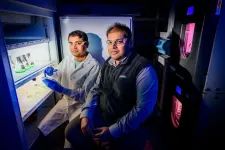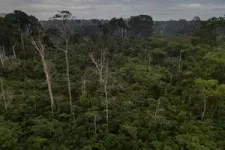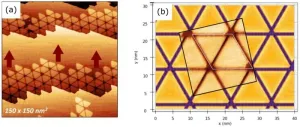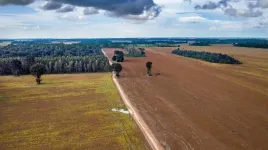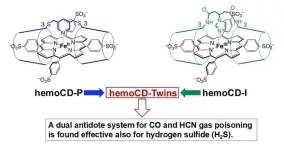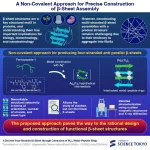(Press-News.org) CHAMPAIGN, Ill. — One of the most momentous events in the history of life involved endosymbiosis — a process by which one organism engulfed another and, instead of ingesting it, incorporated its DNA and functions into itself. Scientific consensus is that this happened twice over the course of evolution, resulting in the energy-generating organelles known as mitochondria and, much later, their photosynthetic counterparts, the plastids.
A new study published in the journal Nature Communications explores the origin of chloroplasts, the plastids that allow plants to extract carbon from the atmosphere to build their own structures and tissues. By focusing on an energy-transport molecule common to plastids, the researchers found evidence suggesting that the primary role of primitive chloroplasts may have been to produce chemical energy for the cell and only later shifted so that most or all of the energy they generated was used for carbon assimilation.
Chloroplasts are believed to have evolved from photosynthetic cyanobacteria, but it isn’t clear what functions the cyanobacteria originally performed for the cells that engulfed them, said University of Illinois Urbana-Champaign chemistry professor Angad Mehta, who led the new research.
“We asked the question: What chemical role did the primitive symbiont that led to chloroplasts perform for the host cell?” he said. “Was it carbon assimilation or ATP synthesis or both?”
Various lines of evidence suggest that the plastids in red algae and another group of photosynthesizing organisms known as glaucophytes resemble more ancient stages of evolution than the chloroplasts of land plants. But current bioinformatics methods can take the field only so far, Mehta said.
A key to the functional evolution of mitochondria and plastids lies in their energy-generating capacities, he said. Both produce ATP, an energy-packed molecule that drives most of the chemical interactions in living cells. And both mitochondria and plastids make use of ADP/ATP carrier translocases, which reside in the membranes of the organelles and swap ATP with its energy-depleted precursor, ADP.
Mehta and his colleagues focused on differences in the activity of the translocases in the plastids of land plants, red algae and glaucophytes to determine whether these differences could offer insight into chloroplast evolution.
In a series of experiments, the researchers engineered cyanobacteria to express one of the three types of translocases. Then they induced artificial endosymbiosis between the engineered cyanobacteria and budding yeast cells. By controlling the laboratory conditions in which these cells lived, the researchers forced the yeast to rely entirely on the cyanobacterial endosymbionts for their energy needs. Mehta’s lab first developed the technique for artificially forcing yeast to internalize cyanobacterial endosymbionts in a study published in 2022.
The experiments revealed striking differences between the activity of the translocases.
“Most notably, we saw that the endosymbionts expressing translocases from the plastids of red algae and glaucophytes were able to export ATP to support endosymbiosis, whereas those from chloroplasts actually imported ATP and were unable to support the energy needs of the endosymbiotic cells,” Mehta said. The land plant chloroplast translocases were importing ATP and expelling ADP.
Because the plastids of red algae and glaucophytes appear to resemble a more ancient form of the photosynthetic organelles, the new findings suggest that chloroplasts once shared their primary function of providing energy to the larger cell. At some point in their evolutionary history, however, the chloroplasts of land plants appear to have shifted to use the ATP they produced via photosynthesis to drive their own carbon-assimilation tasks. It appears that chloroplasts even siphon off some of the ATP generated by mitochondria, Mehta said.
While the new findings do not definitively prove that this is how chloroplasts evolved, it does offer evidence to support this view, Mehta said.
“The proposal is that the initial interaction between the endosymbiont and cell was based on ATP production and ATP supply,” he said. “Now, you can imagine a scenario in which, as these organisms go on to become land plants, they grow in oxygen-rich conditions. This allows the mitochondria to become specialized in ATP synthesis and chloroplasts to focus and become an engine that drives carbon assimilation.”
The Gordon and Betty Moore Foundation and the National Institute of General Medical Sciences at the National Institutes of Health supported this research. Mehta also is an affiliate of the Carl R. Woese Institute for Genomic Biology at the U. of I.
Editor’s note:
To reach Angad Mehta, email apm8@illinois.edu.
The paper “Photosynthetic directed endosymbiosis to investigate the role of bioenergetics in chloroplast function and evolution” is available online or from the U. of I. News Bureau.
DOI: 10.1038/s41467-024-54051-1
END
Study offers insight into chloroplast evolution
Ancient organelles likely originated as energy-producers but later switched to carbon-assimilation
2024-12-10
ELSE PRESS RELEASES FROM THIS DATE:
Advancing the synthesis of two-dimensional gold monolayers
2024-12-10
Nanostructured two-dimensional gold monolayers offer possibilities in catalysis, electronics, and nanotechnology.
Researchers have created nearly freestanding nanostructured two-dimensional (2D) gold monolayers, an impressive feat of nanomaterial engineering that could open up new avenues in catalysis, electronics, and energy conversion.
Gold is an inert metal which typically forms a solid three-dimensional (3D) structure. However, in its 2D form, it can unlock extraordinary properties, such as unique electronic behaviors, enhanced surface reactivity, and immense potential for revolutionary applications in catalysis ...
Human disruption is driving ‘winner’ and ‘loser’ tree species shifts across Brazilian forests
2024-12-10
Fast-growing and small-seeded tree species are dominating Brazilian forests in regions with high levels of deforestation and degradation, a new study shows.
This has potential implications for the ecosystem services these forests provide, including the ability of these ‘disturbed’ forests to absorb and store carbon. This is because these “winning” species grow fast but die young, as their stems and branches are far less dense than the slow growing tree species they replace.
Wildlife species adapted to consuming and dispersing the large seeds of tree species that ...
A novel heme-model compound that treats lethal gas poisoning
2024-12-10
You may not be familiar with hydrogen sulfide, a colorless gas that smells like rotten eggs, and is produced naturally from decaying matter. However, this gas is lethal to breathe in, and hydrogen sulfide present in high concentrations can cause death very rapidly. Its relative density is also greater than air, causing it to accumulate at lower altitudes and posing an enormous threat to workers at sites, such as manholes, sewage systems and mining operations.
Why is hydrogen sulfide so dangerous? It binds strongly to the heme-containing cytochrome c oxidase ...
Shape-changing device helps visually impaired people perform location task as well as sighted people - EMBARGO: Tuesday 10 December (10:00 UK time)
2024-12-10
IMPERIAL COLLEGE LONDON PRESS RELEASE
Under STRICT EMBARGO until:
10 December 2024
10:00 UK TIME / 05:00 ET
Peer-reviewed / Observational study / People
Trial shows no significant difference in performance between visually impaired participants using new device and sighted participants using only natural vision.
Participants performed significantly better using new device than with currently available vibration technology.
The new device is believed to be the most advanced navigation tech of ...
AI predicts that most of the world will see temperatures rise to 3°C much faster than previously expected
2024-12-10
Three leading climate scientists have combined insights from 10 global climate models and, with the help of artificial intelligence (AI), conclude that regional warming thresholds are likely to be reached faster than previously estimated.
The study, published in Environmental Research Letters by IOP Publishing, projects that most land regions as defined by the Intergovernmental Panel on Climate Change (IPCC) will likely surpass the critical 1.5°C threshold by 2040 or earlier. Similarly, several regions are on track to exceed the 3.0°C threshold ...
Second round of FRONTIERS Science Journalism Residency Program awards grants to ten journalists
2024-12-10
The FRONTIERS Science Journalism in Residency Programme has selected ten science journalists to participate in its second round of residencies. The chosen candidates—Marta Abbà, Rina Caballar, Danielle Fleming, Will Grimond, Giorgia Guglielmi, Suvi Jaakkola, Tim Kalvelage, Thomas Reintjes, Senne Starckx, and Meera Subramanian—will spend three to five months in residency at European research institutions, working on their journalistic projects.
The residencies, hosted by institutions in Austria, Denmark, Germany, Italy, the Netherlands, Norway, Spain and the United Kingdom, offer a unique opportunity ...
The inequity of wildfire rescue resources in California
2024-12-10
AUSTIN, TX, December 10, 2024 – Wildfires in California are intensifying due to warmer temperatures and dry vegetation – putting more residents at risk of experiencing costly damages or losing their homes. Marginalized populations (lower income, elderly, and the disabled) often suffer the most and, according to a new study, may receive less economic and emergency assistance compared to wealthy residents.
A detailed analysis of more than 500 California wildfire incidents from 2015 to 2022 by University at Buffalo scientists shows that disaster recovery resources in California favor people living in wealthy communities over disadvantaged ...
Aerosol pollutants from cooking may last longer in the atmosphere – new study
2024-12-10
New insights into the behaviour of aerosols from cooking emissions and sea spray reveal that particles may take up more water than previously thought, potentially changing how long the particles remain in the atmosphere.
Research led by the University of Birmingham found pollutants that form nanostructures could absorb substantially more water than simple models have previously suggested. Taking on water means the droplets become heavier and will eventually be removed from the atmosphere when they fall as rain.
The team, also involving researchers ...
Breakthrough in the precision engineering of four-stranded β-sheets
2024-12-10
A newly developed approach can precisely produce four-stranded β-sheets through metal–peptide coordination, report researchers from Institute of Science Tokyo. Their innovative methodology overcomes long-standing challenges in controlled β-sheet formation, including fibril aggregation and uncontrolled isomeric variation in the final product. This breakthrough could advance the study and application of β-sheets in biotechnology and nanotechnology.
In addition to the natural sequence of amino acids that makes up a protein, their three-dimensional arrangement in space is also critical to their function. For ...
Family income predicts adult problems more than neighborhood poverty
2024-12-10
A new paper in the Journal of Public Health, published by Oxford University Press, finds that household income in early childhood is a stronger and more consistent predictor for several major health-related problems for 17-year-olds than growing up in a poor neighborhood. The neighborhood was a slightly stronger predictor for obesity only.
The Index of Multiple Deprivation, which assesses neighborhoods in the United Kingdom according to factors including unemployment, low levels of education, crime, and barriers ...
LAST 30 PRESS RELEASES:
New modeling approach sheds light on rare gut disease
Study documents potentially hazardous flame retardants in firefighter gear
Can certain bacteria regulate aging of the immune system and its related alterations?
AI model helps diagnose often undetected heart disease from simple EKG
There are fewer online trolls than people think
Cell membrane fluctuations produce electricity
Jeonbuk National University study shows positive parenting can protect adolescents against self-harm
Surface-engineered ZnO nanocrystals to tackle perfluoroalkyl substance contamination
This new understanding of T cell receptors may improve cancer immunotherapies
A new fossil face sheds light on early migrations of ancient human ancestor
A new immunotherapy approach could work for many types of cancer
A new way to diagnose deadly lung infections and save lives
40 percent of MRI signals do not correspond to actual brain activity
How brain-inspired algorithms could drive down AI energy costs
Gum disease may be linked to plaque buildup in arteries, higher risk of major CVD events
Contrails are a major driver of aviation’s climate impact
Structure of dopamine-releasing neurons relates to the type of circuits they form for smell-processing
Reducing social isolation protects the brain in later life
Keeping the heart healthy increases longevity even after cancer
Young adults commonly mix cannabis with nicotine and tobacco
Comprehensive review illuminates tau protein's dual nature in brain health, disease, and emerging psychiatric connections
Book prepares K-12 leaders for the next public health crisis
Storms in the Southern Ocean mitigates global warming
Seals on the move: Research reveals key data for offshore development and international ecology
Sports injuries sustained during your period might be more severe
World's first successful 2 Tbit/s free-space optical communication using small optical terminals mountable on satellites and HAPS
Can intimate relationships affect your heart? New study says ‘yes’
Scalable and healable gradient textiles for multi‑scenario radiative cooling via bicomponent blow spinning
Research shows informed traders never let a good climate crisis go to waste
Intelligent XGBoost framework enhances asphalt pavement skid resistance assessment
[Press-News.org] Study offers insight into chloroplast evolutionAncient organelles likely originated as energy-producers but later switched to carbon-assimilation
